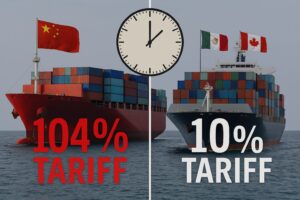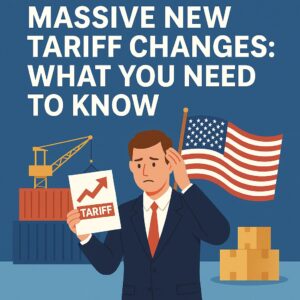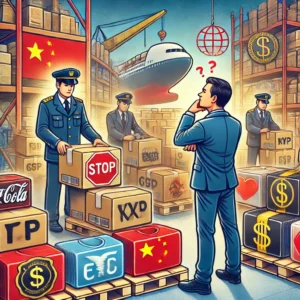With the 2024 U.S. election results in, businesses worldwide are preparing for the impact of the second Trump administration. This post summarizes the key takeaways on trade, immigration, and supply chain challenges from our November 11 webinar.
Whether you’re a seasoned CEO or an emerging entrepreneur, understanding these changes is important for your company to maintain its competitive edge. Let’s take a look at the main takeaways from our expert panel discussion on “The 2024 U.S. Election Is Over. What’s Next for YOUR International Business?”
1. International Trade and Tariffs
Tariffs on Chinese Imports
Expect tariffs as high as 60% on Chinese imports, affecting nearly all goods entering the U.S. from China. Businesses reliant on these imports should immediately begin preparing for higher costs and/or securing alternative suppliers. See How to Leave China Safely.
Global Tariff Increase
Beyond China, the Trump administration will likely implement a 10-20% tariff on imports into the United States from all countries.
Shift to Southeast Asia
Many companies are expected to relocate production from China to Southeast Asian countries like Vietnam, India, Malaysia, and Thailand. These regions offer viable alternatives with lower tariffs. We are also seeing a large number of companies moving their manufacturing to Mexico, including many Chinese companies. See Mexico vs. China on Manufacturing Risks.
2. U.S. Business Immigration Policies
Stricter Visa Regulations
The second Trump administration will tighten visa regulations, particularly for H1B, L1, and O1 visas. Companies should anticipate higher visa denial rates and more stringent application processes, which could affect their ability to hire and retain international talent. We have clients — especially tech clients — opening offices across the borders in both Canada and Mexico, to serve as repositories for incoming tech talent that are denied entry into the United States. Interestingly, we had a rash of Ukrainian and Russian tech companies that did the same thing at the onset of Russia’s invasion of Ukraine.
Increased Travel Bans and Vetting
We are anticipating enhanced travel bans and rigorous vetting of foreigners based on ideology and social media monitoring. Businesses should stay updated on these policies to avoid disruptions in their international operations and to ensure compliance.
Longer Visa Processing Times
Immigration benefits will take longer to process due to immigration staff reductions and stricter enforcement measures. Companies should plan accordingly and keep meticulous records to avoid delays in securing necessary visas for their employees.
3. U.S.-Asia Relations
China-Taiwan Conflict
The potential for tensions or conflict between China and Taiwan poses a significant risk to global supply chains. Companies should constantly evaluate their dependencies on the region and develop contingency plans to mitigate supply chain disruptions. It is not clear whether the Trump administration will exacerbate or ameliorate Taiwan risks.
Relocation of Production
With rising concerns over supply chain stability, businesses are accelerating plans to move production out of China. This will make it easier for China to increasingly mistreat Americans and American companies in China and we expect this sort of retaliation to occur, but we are far from certain on this.
4. U.S.-Latin America Relations
Tariffs on Mexican Goods
President Trump has threatened to impose steep tariffs on Mexican goods — especially autos — if Mexico fails to curb the flow of drugs and criminals into the U.S. Companies with operations in Mexico should brace for potential tariff impacts and explore diversification strategies. We are far more optimistic on this not happening than most, in large part because we see Mexico handling these issues adroitly, just as they did during the first Trump administration.
Mexico as a Beneficiary
Despite potential tariffs, Mexico is likely to be one of the largest beneficiaries from the shift away from China. The country’s proximity to the U.S. and its established manufacturing capabilities make it an attractive alternative for businesses looking to relocate production from China. Again though, we are more optimistic than most on this.
5. U.S.-Europe Relations
Nationalist and Transactional Foreign Policy
Europe’s apprehension about Trump’s foreign policy approach may lead to strained transatlantic business relations.
Increased Defense Spending
With reduced U.S. support for NATO, European countries will likely increase their defense spending and push for an integrated European Army. Businesses in the defense sector should monitor these developments for new opportunities and challenges.
6. Global Supply Chain and Economic Impact
Impact of Tariffs
Tariffs are essentially taxes that increase costs for U.S. importers and consumers. While they aim to reduce trade deficits and protect domestic industries, they often lead to higher prices and economic disruptions. If you listen closely to President Trump on tariffs, you will hear that he often talks about tariffs as a way to eliminate or reduce taxes, more than he talks about it as a way to bring manufacturing back to the United States. Trump has many times said that he loves tariffs, and we believe him, so we see a wide range of tariffs with big impacts.
Diversification and Risk Management
Companies should be looking to diversify their supply chains to mitigate risks associated with geopolitical tensions and tariff increases. Exploring new markets and production locations will likely be key to maintaining stability and growth in many industries.
Economic Power Shift
The tariffs may inadvertently strengthen China’s global economic position as the country will use its lack of access to the U.S. market to direct its efforts at expanding its manufacturing bases worldwide.
Conclusion
The next four years will bring major shifts in international trade, immigration, and supply chains, and it will be important that you stay informed prepared to adapt.
For more insights and updates, subscribe to and/or follow our blog.

























